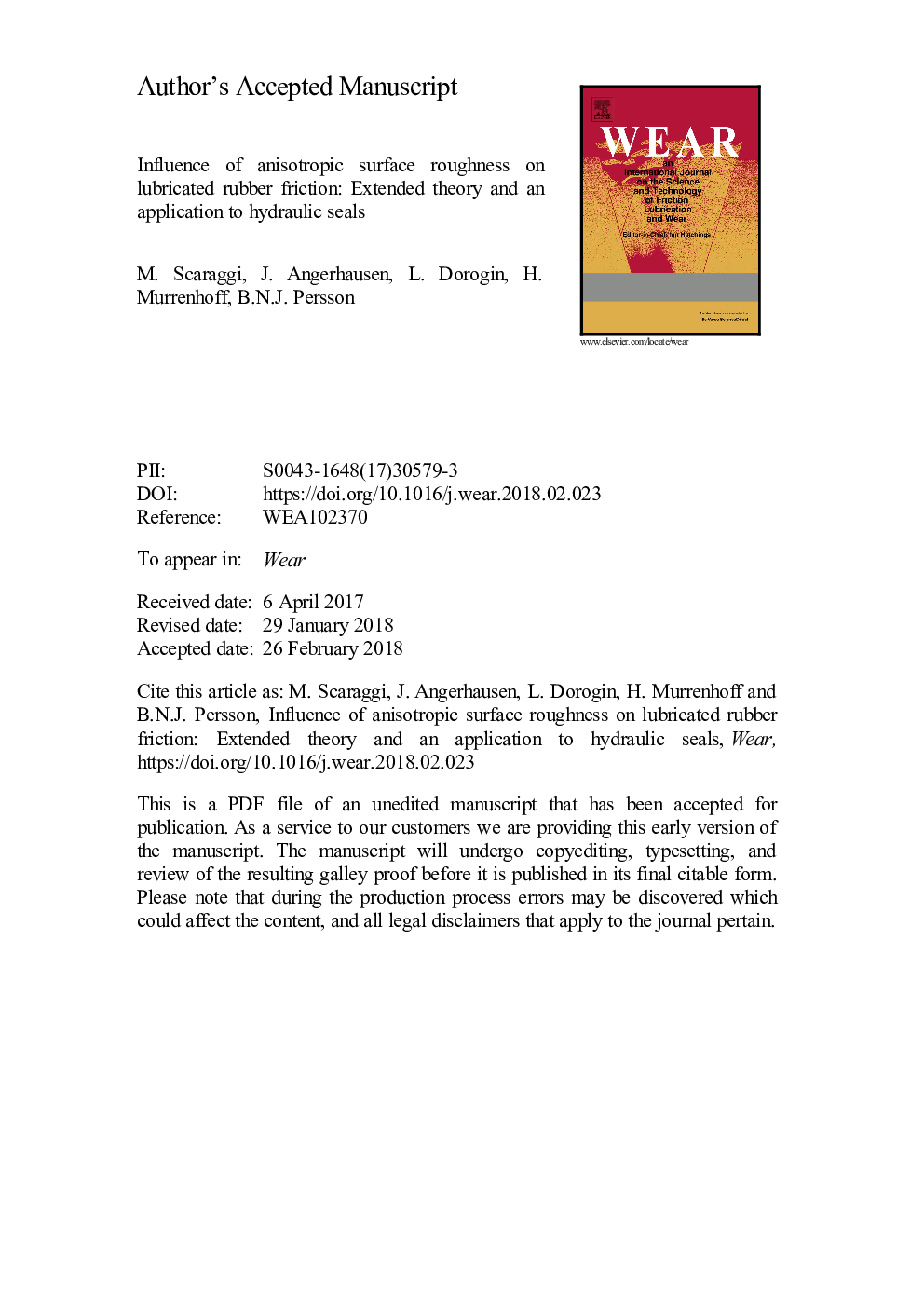| کد مقاله | کد نشریه | سال انتشار | مقاله انگلیسی | نسخه تمام متن |
|---|---|---|---|---|
| 7003727 | 1454935 | 2018 | 25 صفحه PDF | دانلود رایگان |
عنوان انگلیسی مقاله ISI
Influence of anisotropic surface roughness on lubricated rubber friction: Extended theory and an application to hydraulic seals
ترجمه فارسی عنوان
تأثیر ناهمسانی سطح آنیزوتروپیک بر اصطکاک لاستیک روان کننده: نظریه گسترش یافته و کاربرد آن برای مهر و موم هیدرولیک
دانلود مقاله + سفارش ترجمه
دانلود مقاله ISI انگلیسی
رایگان برای ایرانیان
کلمات کلیدی
ترجمه چکیده
عناصر ماشین و اجزای مکانیکی اغلب سطوح با زبری انیزوتروپیک دارند که ممکن است از فرایندهای ماشینکاری حاصل شود، به عنوان مثال سنگ زنی، و یا از پوشیدن. از این رو، مهم است بدانیم که چگونه انجایی قطعیت زبری بر خواص مکانیک تماس، مانند اصطکاک و جداسازی رابط، که برای مخاطبین روانکاری مهم است، تاثیر می گذارد. در اینجا ما یک مدل متوسط-میدان چند عاملی را به مخاطب روانکاری بین یک جامد الاستیک نرم (به عنوان مثال، لاستیک) و یک سطح مقطع سفت و محکم گسترش می دهیم. سطوح را با زبری سطح بی نظیر بررسی می کنیم و بحث می کنیم که چگونه عوامل جریان و جریان اصطکاک سیال به چگالی طیفی قدرت خشن و همچنین مکان زبری بر روی جامدات تعامل بستگی دارد. در نهایت، ما یک بررسی تجربی از تماس کششی روانکاری بین یک حلقه ی لاستیک نوترویل بوتادین و سطوح فولادی با انواع مختلف زبری سطح ایزوتروپیک و آنیزوتروپیک ارائه می دهیم. مقایسه کمی خوب بین نتایج تجربی و پیش بینی های تئوری نشان می دهد که مکانیزم های روانکاری چند منظوره دقیقا توسط این نظریه گرفته شده است.
موضوعات مرتبط
مهندسی و علوم پایه
مهندسی شیمی
شیمی کلوئیدی و سطحی
چکیده انگلیسی
Machine elements and mechanical components have often surfaces with anisotropic roughness, which may result from the machining processes, e.g. grinding, or from wear. Hence, it is important to understand how surface roughness anisotropy affects the contact mechanics properties, such as friction and the interface separation, which is important for lubricated contacts. Here we extend a multiscale mean-field model to the lubricated contact between a soft (e.g. rubber) elastic solid and a rigid countersurface. We consider surfaces with anisotropic surface roughness, and discuss how the fluid flow factors and friction factors depend on the roughness power spectral density, as well as on the location of roughness on the interacting solids. Finally, we present an experimental study of the lubricated sliding contact between a nitrile butadiene rubber O-ring and steel surfaces with different kinds of isotropic and anisotropic surface roughness. The good quantitative comparison between the experimental results and the theory predictions suggests that the multiscale lubrication mechanisms are accurately captured by the theory.
ناشر
Database: Elsevier - ScienceDirect (ساینس دایرکت)
Journal: Wear - Volumes 410â411, 15 September 2018, Pages 43-62
Journal: Wear - Volumes 410â411, 15 September 2018, Pages 43-62
نویسندگان
M. Scaraggi, J. Angerhausen, L. Dorogin, H. Murrenhoff, B.N.J. Persson,
